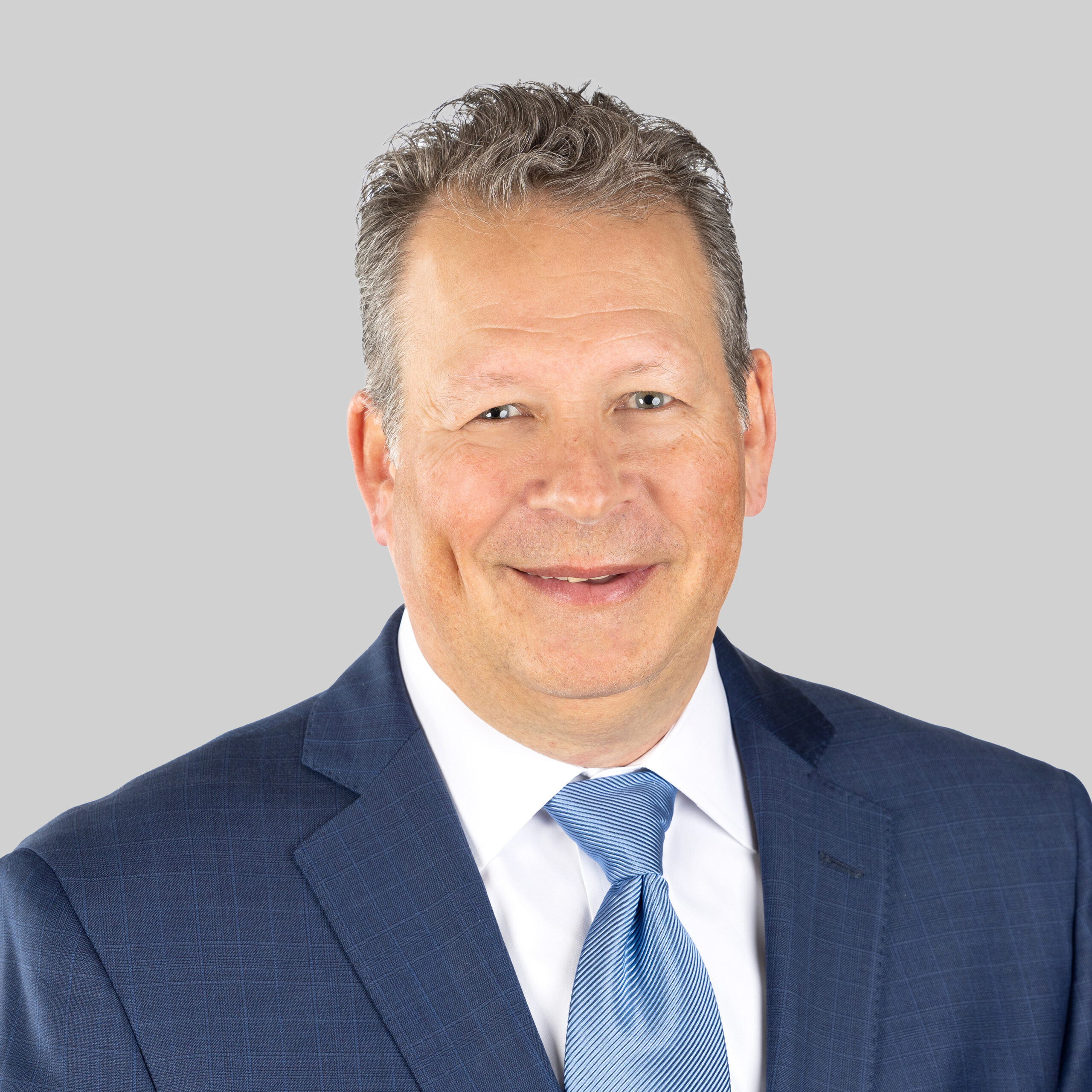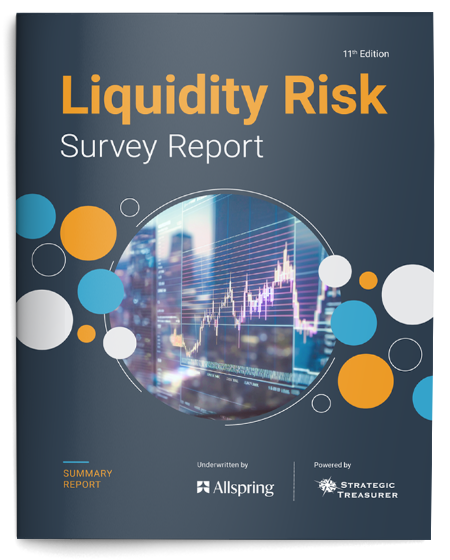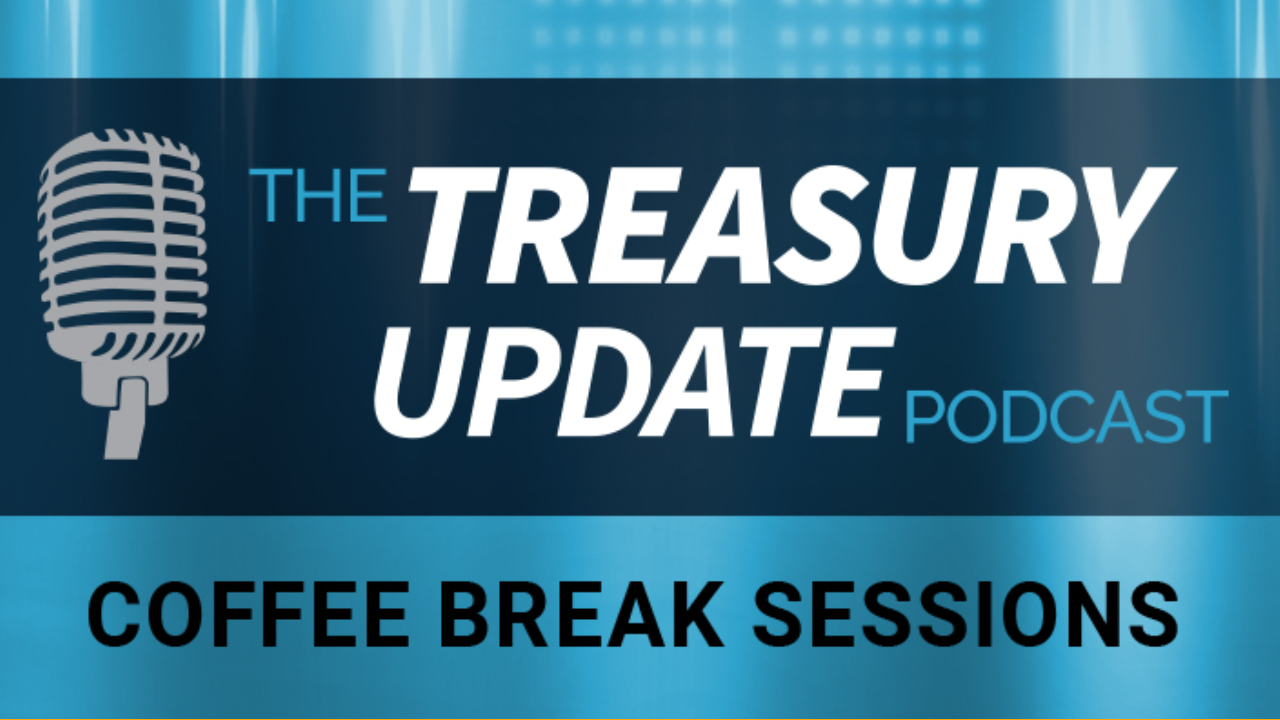
Episode 290
Navigating Banking Changes – Liquidity Risk Survey Results
In today’s episode, Jeff Weaver and host Craig Jeffery discuss key findings from the Liquidity Risk Survey. They discuss impacts of Fed rate increases, the regional bank crisis, and movements in deposits and money funds.
Download your copy of the Liquidity Risk Survey Report here.
Learn more about Allspring here.
Host:
Craig Jeffery, Strategic Treasurer


Speaker:
Jeff Weaver, Allspring


Subscribe to the Treasury Update Podcast on your favorite app!
Episode Transcription - Episode # 290: Navigating Banking Changes - Liquidity Risk Survey Results transcript
Announcer 00:04
Welcome to the Treasury Update Podcast presented by Strategic Treasurer, your source for interesting treasury news, analysis, and insights in your car, at the gym, or wherever you decide to tune in.
Craig Jeffery 00:18
Welcome to the Treasury Update Podcast. This is Craig Jeffery, I’m your host today and I’m here with Jeff Weaver from Allspring. Today’s episode is a 2023 recap and 2024 outlook on liquidity. And this is fueled in part by the Liquidity Risk Survey Report which was underwritten by Allspring this year. Welcome to the podcast, Jeff.
Jeff Weaver 00:41
Thank you, Craig. Happy to be here.
Craig Jeffery 00:43
Jeff, I know he’s got a lot of content to cover. I thought it’d be great if you could just do a quick intro on your role at Allspring and then we can then we can move into the review of 2023.
Jeff Weaver 00:58
Yeah, my name is Jeff Weaver. I am head of global liquidity solutions here at Allspring Global Investments. In that role, I oversee 207 billion in money market fund assets. We’re the 11th largest provider of money market funds in the industry. My team also oversees 20 billion and short duration separate accounts largely for institutions BARCHI corporate treasury staffs.
Craig Jeffery 01:22
Allspring is a relatively new name but a long standing company. Is there anything you want to just update people on?
Jeff Weaver 01:30
Yes, Allspring Global Investments has now been in existence since 2021. We just passed our second year of existence. And of course, that all spring Global Investments came from what was originally Wells Fargo asset management, I joined Wells Fargo Asset Management in 1994, after starting my career in 1990, at Bankers Trust Company, and now really excited to be part of all spring global investments as we create a world class standalone investment manager.
Craig Jeffery 02:00
So thank you, and thank you to Allspring for picking up the underwriting of liquidity risk survey report, this is the 11th additional just give a little bit of background, we’re not going to go through the report in great detail. But there will be links in the show notes where you can download the report at over 160 respondents over 50 Questions 11th year research covers a significant number of areas, there’s a lot of really good information for people to look at. And to read. So we invite you to look at the show notes or stop by StrategicTreasurer.com. Maybe we could start Jeff, by talking about the recent history, a bit of a review on the past 12 to 18 months there certainly, there’s a lot of changes, maybe you could summarize this period, let’s say from the investment lens or investment perspective.
Jeff Weaver 02:51
Sure, happy to know back in March of 2022, the Fed began to increase the Fed funds rate to combat inflation that really was a result of the of the COVID epidemic. And they ended up increasing having to increase rates a lot quicker than people expected. In 2022, they increased rates the Fed funds rate by 425 basis points. And they continued that into 2023. Ultimately, hiking another 100 basis points to to land at 525 basis points Fed funds rate because of the speed and the and the size of the increase that was certainly significant in fixed income markets and markets in general. And we got to a point in March where a couple of regional banks had to start to sell securities to meet deposit needs. And they were selling the securities at at at losses because rates had gone up so much. So in March of last year, we saw Silicon Valley Bank first republic Signature Bank all fail. And that was a real significant juncture in the market and that rates had gone up and something something broke, it was interesting to see investor reactions to that and that they started to withdraw their deposits from these regional banks, they started to put those deposits into higher quality banks, they noticed that after rates have gone up so substantially, that they could really earn a market rate of return away from banks, bank deposit rates tend to be lower, they tend they tend to be very slow to increase rates as rates are going up. And they also are quick to decrease them as rates go down. But what investors realize is that it could earn a market rate of return and money market funds away from bank deposits. And so you saw this massive inflow of of investments into money market funds to the tune of about $1.1 trillion, increasing industry assets to about 6.3 trillion, so an increase of about 22%. So an impressive a an impressive amount for sure.
Craig Jeffery 04:56
And that’s certainly a lot of a lot of movement. And you know, as you said the Uh, you know, rates moved off the floor, they moved up really rapidly. And there was this these regional bank crises, I guess it was actually broader than regional banks. And that created this, this movement, you know, in addition to moving to, let’s say, larger banks, higher, higher credit quality banks, what other what other activities were corporate treasury groups doing? Where are they taking, what other steps are they taking?
05:27
The big move was corporate treasurers moving money into money market funds, we saw $1.1 trillion come into the money market industry, we saw a drop of about seven to 800 billion in bank deposits. So there was a switch out of bank deposits into money market funds, seeking to get that that market rate of return yields on money market funds are so highly correlated with the Fed funds rate, that all of a sudden, investors could earn a really attractive rate in and around five and a quarter, five and a half percent. So those are those are rates that we haven’t seen in money market funds for a long time, particularly when 10 of the last 15 years, we’ve been in a an environment where the Fed was at at 0% interest rates. So a nice change for the money market fund industry for sure.
Craig Jeffery 06:19
Yeah, Jeff, you know, it’s one of the one of the survey results about have your banks talk to you about your deposit balances? We asked that question every year, and there’s quite a few years of the survey, going back to 2019 0% said, banks had conversation with them, and wanted to increase one of them to increase the levels of deposit balances that went up from zero to 33%, from 2019 to the survey in 2023. So, certainly, you know, the movement out meant their rates balances are a lot more attractive, what else is making cash attractive in this move to the money market funds.
07:01
Why deposits and money market funds are so attractive to corporate treasurers is the fact that there is this premium, this preference for liquidity and preservation of principle. So, you know, you really tend to get a concentration in deposits and in money market funds, because they have liquidity because there is it’s high quality, you know, very little risk of losing principal. But now you also achieve this third objective of, of obtaining a really attractive competitive yield up around five and a quarter percent. So, the choice has been easy to move out of deposits into money market funds to achieve this, to achieve this higher rate of return this higher yield without sacrificing liquidity and preservation of principle.
Craig Jeffery 07:51
Jeff, the preservation of capital, like we see in the surveys listed to safety, liquidity and yield, you know, overall, respondents identified number one was safety at 64%. Liquidity is 28%. And yield was 8%. Pretty significant difference between let’s say the largest companies 75%, put safety first, smallest companies 47% percent put safety first, just kind of interesting to see the different dimensions, different responses based on size. And the reason for that, that you can think of?
08:26
Regardless of size, cash is dear to corporations. And they want to make sure that that cash is available for investing in their company for making investments in their growth. And so they want to make sure that that money is available to them and not at risk of loss. And so, investments in deposits, investments in money market funds, certainly achieve that high preservation of principle those liquidity needs. And what’s interesting about today is that you can earn a very attractive yield and doing so again, up around five and a quarter, five and a half percent.
Craig Jeffery 08:59
The other item under the safety liquidity yield 20% was identified as liquidity. But if you look at small firms, 50% of those the largest response identified liquidity is number one, and you can think of access to capital in the broader markets, they have a harder time gaining access to capital. So some real good cuts of information here. Jeff, as we shift from what’s happened in in the recent past to how money is moved around, let’s look at 2024. You know, tell us what you think we can reasonably expect in the next 12 months? And how how can we perhaps better manage our activities to reflect the expectations that you have? And they’re reasonable, given with nobody has perfect insight into the future? It’s not gonna be 100%. So what’s, what’s a reasonable approach given what your best views of expectations are?
09:57
The Fed last increased rates in July. They’ve been on pause since then, the current Fed funds rate is five and a quarter to five and a half percent range. And we do expect that to come down and 2024 They’ve been really the Fed has been really successful in bringing inflation down. When we look at inflation readings, and we look at, you know, their preferred measure, which is the core personal consumption expenditure numbers, when we look at PCE, we see headline year over year down to 2.6%. We see core PCE down to 3.2%. And when you look at the last six months, core PCE has averaged 1.9% On an annualized basis. So that’s really getting close to that to the Feds target rate of 2%. And so they’ve got to be quite pleased with the fact that inflation has come down, and certainly the market is pleased with it. The market is currently pricing and pretty aggressive rate cuts by the Fed in 2024, with six rate cuts priced in by the end of 2024, a seven by January of 2025. So we do expect the Fed to start cutting rates, rate increases are behind us. And if anything at this point, I think the market is probably a little aggressive and pricing and rate cuts. Right now, the markets pricing in about a 67% chance of the first rate cut beginning and March, we think it’s more likely that they start in May, and cut rates by about 100 basis points on the year. So we do think rates are going to come down. We do you think the Fed will be cutting, cutting interest rates because they have been able to control inflation. I think the market right now is quite as being a little overly aggressive in pricing in those rate cuts. But nonetheless, the trend is lower. And so we we as money managers have been extending our durations and takes anticipation of those rate cuts. We’ve been extending the weighted average life of our of our money market portfolios, we’ve been extending the duration of our separate accounts in anticipation of those lower rates. So what investors should consider is how to best take advantage of the falling rate environment, quite frankly, even with the Fed funds rate down 100 basis points, by the end of this next year, cash is still going to be quite attractive. And for those portfolios that have extended, they will benefit as rates decrease, I think it’s important for investors consider to consider locking in these rates by extending durations on their own.
Craig Jeffery 12:22
So if the rates are gonna go down, extending duration or her buying instruments that are a little farther out on the yield curve now before they dip, that may have some some benefits for those that have that liquidity needs that that can handle that. What do you think people would would be choosing to do during this time to take advantage of all the expectations of a decrease in rates.
12:44
So investors can take advantage of these higher rates now before they fall by extending in durations by purchasing securities on their own making direct purchases by utilizing separate accounts, or also by utilizing ultra short or short term bond funds, we would expect interest in direct purchases and separate accounts to increase over the course of 2024.
Craig Jeffery 13:08
We’ve seen the shifts between money market funds, whether they’re prime oriented or government, as rates as rates rise, and as some of the regulations on money, money funds become a reality. What do you expect will happen with the the flow of funds brought about by these, at least these two changes.
13:29
Certainly the increase in rates that we’ve witnessed over the last 18 months with made money funds quite attractive. One of the things that is on the horizon that folks should be aware of is the implementation of, of new SEC reform on the money fund industry. And we do expect that there will be a shift out of institutional prime funds into government funds as we approach it, October 2 2024 implementation date of mandatory liquidity fees, we think that that’s not a great development for institutional investors. And we do think that there will be a shift out of institutional prime into government funds as a result.
Craig Jeffery 14:09
You’d mentioned separate accounts before let me just do a little bit of setup for the question I have for you there. Obviously, if you’re in a money market fund or a fund, it’s a it’s a mutual experience, you’re sharing it with other investors, their actions can have some kind of feedback effect, or impact separate accounts are it’s your own company’s funds you you don’t have the advantage of sharing in broad liquidity. It’s your own liquidity, but that also gives you more control. And I think you were you were describing your assets and sounded like about 9% of the assets in this sector at Allspring are separate accounts. Why would people move to a separate account in this environment of falling rates? And what would that look like? What would be some guide guidelines you’d have for people on this to the if that’s the case?
Jeff Weaver 14:57
We see an increase in demand for separate accounts when rates be tend to fall, because investors want to lock in those rates and in a separate account, one can really customize their guidelines customize their investments to meet those meet the liquidity needs, unique to the client. And in doing so you can achieve some greater returns, while also structuring these accounts to meet liquidity needs. So a lot of times in money market funds, there’s too much liquidity that’s available. And for those clients that have some known cash flow, some known liquidity needs, we construct your separate accounts to to achieve those higher returns while meeting those liquidity needs.
Craig Jeffery 15:36
That makes sense. So am I right in assuming that your view is because of a falling rate environment, there’s going to be more attention paid or or a little bit more priority, pay to yield obviously, safety, safety and liquidity, there are almost always gonna be first and second. But those that focus on yield will pay more attention to it. Some will go into separately managed accounts to accomplish this. Is that Is that fair? Is there any additional color on that?
Jeff Weaver 16:06
When rates are increasing, there’s always a great concern about loss of principal. And so I think corporate Treasurers and corporate treasury departments want to know that the Fed has done before they invest further out the curve. We’re at a point now where we believe the Fed has done, clients can extend out the curve via a separate account or other vehicle in order to take advantage of these higher rates while they can before rates actually start to fall. So we expect the Fed funds rate to decline by 100 basis points this year, the market is even expecting more. But one thing’s for sure is by extending today, clients can lock in these higher yields for longer and benefit from capital appreciation as rates fall.
Craig Jeffery 16:44
A little more control over your your investment destiny, when that matters, and other things that you would be advising corporate treasurers or corporate investment managers to be mindful of as we move through the year, let’s say things don’t progress. As anticipated. I think the Feds been pretty clear about their guidance, the market expectation seems to align pretty well. Anything that you would say keep a watch out on this or this item?
Jeff Weaver 17:13
I think the Federal Reserve’s in a great spot right now, and that they’re trying to navigate the soft landing of monetary policy, they have inflation coming down, they still have a strong economy, they still have full employment. And so they’re trying to navigate this landing in which in which they’re able to maintain those, those positive factors, to the extent that inflation picks up again, you know, I think the Fed is very concerned about that. And that’s why they’re, they’re pushing back on the market. With the market’s expectations for rate cuts, the Fed is pushing back and saying, Look, we’re not going to ease too early, we want to make sure that our job is done with inflation. We don’t want to stop easing too early, and risk inflation coming back up. So, you know, we do think that the Fed is very wary of that. Any pushback that you see from the Fed is usually about keeping rates higher for longer versus the market expectations of them cutting, cutting rates more aggressively. I think that’s something that we investors will keep our eye on. Conversely, you know, if the Fed keeps rates up too high, for too long, they were there is a risk of a recession. And we’ve been in this inverted yield curve for some time. And typically, that inverted yield curve is an indication that we could move into recession. So there is this, there is this, this fine line that the Fed is trying to engineer the soft landing, it’s quite possible that banks want to start making their deposits more attractive that it’s quite possible that they want to grow, that they want to grow deposits. So it’s quite possible we start to see deposit rates be more attractive, whether that be in outright deposit rates or in the form of an earnings credit rate and or an ECR. So it’s quite possible that we see banks look to grow their deposits this year. Something to be mindful of.
Craig Jeffery 19:06
Yeah, we see that in the the number of conversations that banks have had with their corporate clients. Excellent. Jeff, thank you so much for sharing, sharing your thoughts on this podcast also for your end Allsprings underwriting liquidity risk survey report. Again, I’ll point you to the show notes to download that report for free. Thanks for joining me.
Jeff Weaver 19:28
Craig. Thank you.
Announcer 19:32
You’ve reached the end of another episode of the Treasury Update Podcast. Be sure to follow Strategic Treasurer on LinkedIn. Just search for Strategic Treasurer. This podcast is provided for informational purposes only, and statements made by Strategic Treasurer LLC on this podcast are not intended as legal, business, consulting, or tax advice. For more information, visit and bookmark StrategicTreasurer.com.
Related Resources
A part of the Treasury Update Podcast, Coffee Break Sessions are 6-12 minute bite-size episodes covering foundational topics and core treasury issues in about the same amount of time it takes you to drink your coffee. The show episodes are released every first and third Thursday of the month with Host Jonathan Jeffery of Strategic Treasurer.







